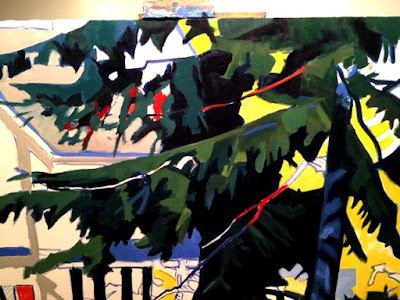Growing Art Takes Time
Once when she was little I was showing my one of my daughters how I make my big paintings by building up layer upon layer of paint until I get the colors to behave just right. She asked "why don't you just paint the right color the first time? Then you'd be done real fast."
This is a detail of the 36 x 54 inch canvas I'm working on on my easel right now. It's based on the smaller oil below, Beneath the Pine, 19 x 28 inches, 2019 (at Courthouse Gallery Fine Art in Ellsworth, ME). At this early blocking-in stage the painting has a flat look. But I'm just getting the lay of the land. Later on I'll be going back over 99% of its surface and repainting each area to give it a fine tuning. Some areas will need to be painted over 3 (or more) times to get them to behave properly.
I work with oil pigments in a wet-into-wet method that's made possible by the paint's slow drying time. Sometimes two adjacent colors need to contrast each other as sharply as possible. Other times they need to have that contrast softened. Oil paint allows me to blend the different colors into each other, softening or even completely eliminating the boundary between the colors.
Here's a close up of a passage in another of my new paintings, Bright October Sun, 36 x 54 inches, 2019.
This is the tip of a huge dome-shaped sand dune. You can see how the warm white oil paint I've used for the highlighted sand in some places has been blended into the adjoining brushstrokes of light blue gray shadow to give a sense of volume. In other places those same strokes of warm white are left crisply contrasting the darkest foliage. There is a balancing act between establishing the weight and volume of the dune played off against the energy injected by the abstract patterns of the plants.
Here's the entire Bright October Sun canvas I took the last detail from.
I would love to "paint the right color the first time" as my daughter suggested, but that's not possible. Starting a big painting is a little like trying to set a table for six dinner guests but doing it in complete darkness. Feeling your way with your hands you might get the silverware at least near each plate, but in the end the table is going to look erratic as heck. Your guests will wonder about you.
Taking the time to build up my painting in layers is my way of slowly turning up the light as I go in my imaginary dining room. With relentless small adjustments we can get the crispness or the softness of my edges and the little calibrations of color to come together. After all, we're hosting a grand banquet for the eyes.






